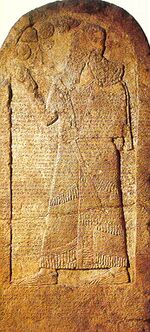Battle of Qarqar facts for kids
Quick facts for kids Battle of Qarqar |
|||||||
|---|---|---|---|---|---|---|---|
| Part of the Assyrian conquest of Aram | |||||||
 Kurkh stele of Shalmaneser depicting the battle |
|||||||
|
|||||||
| Belligerents | |||||||
| Neo-Assyrian Empire | 12 Kings alliance: Hama Israel Aram-Damascus Ammon Qedar Arwad Quwê Irqanata Shianu |
||||||
| Commanders and leaders | |||||||
| Shalmaneser III | Irhuleni of Hama Ahab of Israel Hadadezer of Aram-Damascus Baʻsa of Ammon Gindibu of Qedar Matinu Baal of Arwad Kate of Quwê Adunu Baal of Shianu |
||||||
| Strength | |||||||
| 35,000, including: 20,000 infantry, 12,000 cavalry, 1,200 chariots, |
53,000–63,000 infantry, 4,000 chariots, 2,000 cavalry, 1,000 camel cavalry |
||||||
| Casualties and losses | |||||||
| Unknown | Unknown | ||||||
The Battle of Qarqar was a huge fight that happened in 853 BC. It was between the powerful Neo-Assyrian Empire, led by Emperor Shalmaneser III, and a large group of eleven kings who had teamed up. This battle took place near a town called Qarqar.
The leaders of the allied kings were Hadadezer from Aram-Damascus and Ahab, the king of Israel. This battle was special because it involved more soldiers than any fight before it. It was also the first time some groups, like the Arabs, were mentioned in history books. We know about this battle from ancient writings found on the Kurkh Monoliths.
Contents
Where the Battle Happened
The ancient town of Qarqar, where this big battle took place, is believed to be the modern-day archaeological site of Tell Qarqur. This site is located near the village of Qarqur in northwestern Syria. It's in an area called the Hama Governorate.
Shalmaneser's Journey to Qarqar
According to records from Shalmaneser himself, he started his yearly military trip in the spring. He left his capital city, Nineveh, and traveled across two major rivers, the Tigris and the Euphrates. Along the way, many cities, including Aleppo, surrendered and offered him gifts.
After passing Aleppo, Shalmaneser faced his first challenge. He met the troops of Irhuleni, the king of Hama. Shalmaneser defeated Irhuleni and then looted his palaces and cities. After attacking Qarqar, Shalmaneser's army continued marching. They soon met the allied forces near the Orontes River, and that's where the big battle began.
The Alliance of "Twelve Kings"
The term "Twelve Kings" was an ancient way of saying "a big alliance" in the Akkadian language. Even though the Assyrian records say "twelve," there were actually eleven kings who joined forces against Shalmaneser III at Qarqar.
Shalmaneser's records describe the armies of his opponents in great detail:
- King Hadadezer led a large force with 1,200 chariots, 1,200 horsemen, and 20,000 soldiers.
- King Irhuleni of Hama brought 700 chariots, 700 horsemen, and 10,000 soldiers.
- King Ahab of Israel sent 2,000 chariots and 10,000 soldiers. The number of chariots from Ahab is a topic scholars discuss.
- The land of Quwê-Cilicia sent 500 soldiers.
- The land of Masura sent 1,000 soldiers.
- The land of Irqanata (Tell Arqa) sent 10 chariots and 10,000 soldiers.
- King Matinu Baal of Arwad sent 200 soldiers.
- The land of Usannata sent 200 soldiers.
- King Adunu Baal of Ušnatu also sent troops, but the exact numbers are missing.
- King Gindibu of Arabia sent 1,000 soldiers who rode camels.
- King Ba'asa of the land of Ammon sent 100 soldiers.
How Many Chariots Did Ahab Have?
The number of chariots Ahab of Israel sent is a bit of a mystery for historians. Some think it's unlikely that Israel had more chariots than the powerful Kingdom of Aram-Damascus. They suggest the number might have been closer to a few hundred.
However, archaeological digs have found large stable complexes at places like Tel Meggido. These stables could have held many chariots. If King Ahab had many such stables across his kingdom, it's possible he could have gathered a large chariot force. Some scholars believe the number 2,000 might be a mistake in the ancient writing, or that it included chariots from Israel's allies like the Kingdom of Judah.
The Battle Itself
Shalmaneser's own account of the battle says he won a huge victory. He wrote that he fought with the power given to him by his god, Aššur. He claimed to have defeated the allied armies from Qarqar all the way to Gilzau. He said he killed 14,000 enemy soldiers and filled the plain with their bodies. He even claimed to have blocked the Orontes river with their corpses. He also said he captured many chariots, cavalry, and horses during the fight.
However, we need to be careful when reading these ancient royal records. Kings often exaggerated their victories and never admitted to defeats. If Shalmaneser had truly won such a huge victory at Qarqar, he didn't immediately conquer more land in Syria. Assyrian records show that he had to fight in the region many more times in the years that followed. He fought Hadadezer six more times, and Irhuleni of Hama supported Hadadezer at least twice. This suggests that the battle was not a complete win for Shalmaneser.
After the battle, Shalmaneser's opponents kept their thrones. While Ahab of Israel died later in a different battle, Hadadezer remained king of Damascus for many more years. This shows that the Battle of Qarqar was likely an indecisive battle, meaning neither side won a clear victory. It stopped the Assyrian advance for a while.

